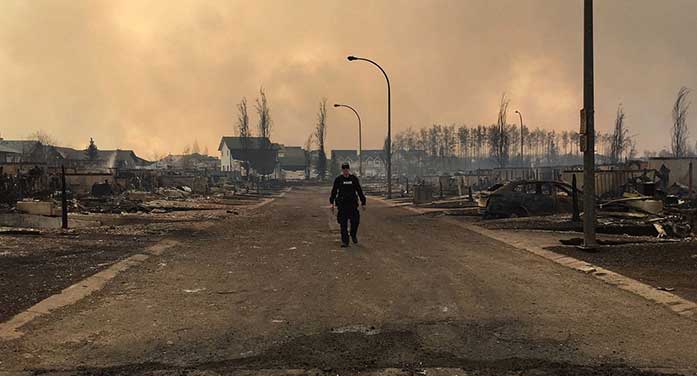A study on the health of RCMP officers who were deployed to the Fort McMurray wildfires in 2016 has found that their airway function was compromised in the first three months after deployment. An analysis of health data from 218 officers revealed that the small airways in their lungs underwent structural changes after they were deployed, potentially increasing their risk for respiratory diseases in the future.

Paige Lacy
“We cannot tell from our study whether it’s long-lasting damage, but we do know from other studies that if people are exposed to high levels of particulate matter in the air, they are more likely to suffer from long-lasting damage to the lungs,” said Paige Lacy, professor of medicine at the University of Alberta and former director of research for the Alberta Respiratory Centre.
The Fort McMurray wildfires caused the largest evacuation in Canadian history, with more than 80,000 people rapidly removed from the community as fires encroached on the city. Hundreds of RCMP members were sent to the community to assist with the evacuation and to secure the area in the following days.
“There was very little time for people to respond in terms of making sure that everyone was safely fitted with personal protection equipment. So what we found was that there was variable use of personal protection equipment while they were deployed,” added Lacy.
The lung-function data were gathered as part of a larger study being conducted by Synergy Respiratory and Cardiac Care, looking at the health of RCMP officers dispatched to the Fort McMurray wildfire. According to the researchers, the subtle differences in lung function that were found were not measurable using traditional lung-function tests, and could only be observed through the use of more sensitive instruments.
“Small airways are potentially more vulnerable and there is no way that a spirometer (a device commonly used to measure lung function) can detect the progression of their damage over time,” said Subhabrata Moitra, first author on the study and a post-doctoral fellow in the U of A’s Division of Pulmonary Medicine. “So if we use those highly sensitive instruments, we can immediately get some signals whether there are any acute yet subtle changes caused by physiological factors or occupational or environmental hazards.”
The researchers noted that because the officers only came in for testing once after being deployed, they were not able to observe potential recovery of lung function or measure long-term damage.
The researchers believe first responders such as the RCMP must be better prepared for similar situations in the future. Though evacuations on the scale of the Fort McMurray wildfire may not be the norm, more intense wildfires requiring deployment are likely.
“Wildfires are going to become the norm for us, unfortunately. We saw that this summer, we saw that in previous summers. They are increasing in frequency and they’re increasing in intensity,” said Moitra. “We can try to do better forest management, but if we can’t prevent the wildfires from happening, then at least we can ensure first responders going in have properly fitted personal protection equipment. These people are going to go in repeatedly over the years and every time they are exposed, they’re increasing that risk of long-lasting damage to the lungs.”
“It’s important that the officers have their own personally fitted personal protection equipment before they go to wildfires,” said Lacy. “Firefighters already have that. But for RCMP, it seems like it’s not really incorporated in their practice normally, so maybe they should seriously think about that.”
The researchers also noted the importance of having a health-surveillance program in place in the future so responders who are exposed to such hazards can have their health monitored.
Funding for the study was provided by Synergy Respiratory and Cardiac Care.
“Short-Term Acute Exposure to Wildfire Smoke and Lung Function Among Royal Canadian Mounted Police (RCMP) Officers” was published in the International Journal of Environmental Research and Public Health.
| By Ross Neitz
Submitted by the University of Alberta’s Folio online magazine. The University of Alberta is a Troy Media Editorial Content Provider Partner.
© Troy Media
Troy Media is an editorial content provider to media outlets and its own hosted community news outlets across Canada.

